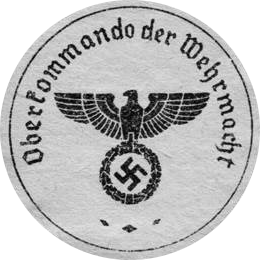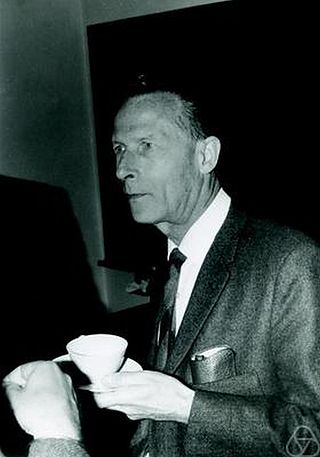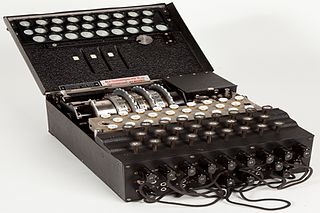
The Oberkommando der Wehrmacht was the supreme military command and control office of Nazi Germany during World War II. Created in 1938, the OKW replaced the Reich Ministry of War and had oversight over the individual high commands of the country's armed forces: the army, navy, and air force.
TICOM was a secret Allied project formed in World War II to find and seize German intelligence assets, particularly in the field of cryptology and signals intelligence.
German code breaking in World War II achieved some notable successes cracking British naval ciphers until well into the fourth year of the war, using the extensive German radio intelligence operations during World War II. Cryptanalysis also suffered from a problem typical of the German armed forces of the time: numerous branches and institutions maintained their own cryptographic departments, working on their own without collaboration or sharing results or methods. This led to duplicated effort, a fragmentation of potential, and lower efficiency than might have been achieved. There was no central German cryptography agency comparable to Britain’s Government Code and Cypher School (GC&CS), based at Bletchley Park.
The Cipher Department of the High Command of the Wehrmacht was the Signal Intelligence Agency of the Supreme Command of the Armed Forces of the German Armed Forces before and during World War II. OKW/Chi, within the formal order of battle hierarchy OKW/WFsT/Ag WNV/Chi, dealt with the cryptanalysis and deciphering of enemy and neutral states' message traffic and security control of its own key processes and machinery, such as the rotor cipher ENIGMA machine. It was the successor to the former Chi bureau of the Reichswehr Ministry.
The Research Office of the Reich Air Ministry was the signals intelligence and cryptanalytic agency of the German Nazi Party from 1933 to 1945. Run since its inception by Luftwaffe chief Hermann Göring, the Research Bureau was a Nazi Party institution rather than an official Wehrmacht-run military signals intelligence and cryptographic agency.
The Pers Z S was the signals intelligence agency of the German Foreign Office before and during World War II. It consisted of two cryptologic sections. Pers Z S was the cryptanalytic section which was called Special Service of Z Branch of the Foreign Office Personnel Department. Its mission was the solution of foreign diplomatic codes and ciphers. The other section, which was the Cryptography Section was called Personal Z Cipher Service of the Federal Foreign Office. The latter section was responsible for compilation, distribution and security of Foreign Office codes and ciphers. Both were colloquially known as Pers Z S. Though similar in nature and operation to the OKW/Chi cipher bureau, it was a civilian operation as opposed to the military operation at OKW/Chi and focused primarily on diplomatic communications. According to TICOM interrogators it evinced an extraordinary degree of competence, primarily driven by a consistency of development not found in any other German signals bureau of the period. Pers Z S/Chi was the symbol and the code name of the Chiffrierdienst, i.e. the Cryptanalysis Department of Pers Z S. Although little is known about the organization, in the final analysis, Pers Z S labored at diplomatic cryptanalysis for a regime for which there were no diplomatic solutions.

Wilhelm Fenner was a German cryptanalyst, before and during the time of World War II in the OKW/Chi, the Cipher Department of the High Command of the Wehrmacht, working within the main cryptanalysis group, and entrusted with deciphering enemy message traffic (Cryptography). Wilhelm Fenner was considered an excellent organizer, an anti-Nazi, an anti-Bolshevik and a confirmed Protestant and was known by colleagues as someone who was keen to continue working in cryptology after World War II. To quote military historian David Alvarez:

Erich Hüttenhain was a German academic mathematician and cryptographer (Cryptography) and considered a leading cryptanalyst in the Third Reich. He was Head of the cryptanalysis unit at OKW/Chi, the Cipher Department of the High Command of the Wehrmacht.

Walter Ernst Fricke was a distinguished German professor of theoretical astronomy at the University of Heidelberg. He was a mathematician and cryptanalyst during World War II at the Wehrmacht signals intelligence agency, Inspectorate 7/VI from 1941 to 1942 (which would later become the General der Nachrichtenaufklärung. In 1942 he was transferred to the OKW/Chi Section IIb. His specialty was the production of codes and ciphers, and the security studies of Army systems. After the war he was director of the Astronomical Calculation Institute in Heidelberg, Germany.
General der Nachrichtenaufklärung was the signals intelligence agency of the Heer, before and during World War II. It was the successor to the former cipher bureau known as Inspectorate 7/VI in operation between 1940 and 1942, when it was further reorganised into the Headquarters for Signal Intelligence between 1942 and 1944, until it was finally reorganised in October 1944 into the GdNA. The agency was also known at the OKH/Gend Na, GendNa or Inspectorate 7 or more commonly OKH/GdNA. Inspectorate 7/VI was also known as In 7 or In/7 or In 7/VI and also OKH/Chi.
Ostwin Fritz Menzer was a German cryptologist, who before and during World War II, worked in the In 7/VI, the Wehrmacht signals intelligence agency, later working in that was the cipher bureau of the supreme command of the Nazi party, and later in Abwehr, the military intelligence service of the Wehrmacht. He was involved in the development and production of cryptographic devices and procedures, as well as the security control of their own methods.
Otto Buggisch was a German mathematician who, during World War II, was a cryptanalyst working in the cipher bureau, the Cipher Department of the High Command of the Wehrmacht (OKW/Chi) responsible for deciphering of the opposing forces Communications. He also dealt with the security control of own key procedures. Through research and revelations exposed by two Polish officers, late in the war, he recognized the true cryptographic weaknesses of the Enigma rotor cipher, key machine used by the German armed forces to encrypt their secret communications, in World War II.
Herbert Julius von Denffer was a German actuarial mathematician. He was born in Narva, Estonia. During World War II, Denffer worked as a cryptanalyst in Referat F, the Mathematical Referat, as part of the Inspectorate 7/VI, that was the signals intelligence agency of the Wehrmacht, before and during World War II. He would later work for the General der Nachrichtenaufklärung, the successor organization to the In 7/VI, specifically undertaking research in general theory of cryptography.
Johannes Anton Marquart was a German actuarial and insurance mathematician. During World War II, Marquart was employed into the Germany Army Inspectorate 7/VI, in 1940, which later became the General der Nachrichtenaufklärung. He eventually became head of Referat Ia of Group IV of the organization in November 1944 engaged in research into German Army hand cryptographic systems. Prior to that period Marquart had been chief cryptanalysis in KONA 5.

Rudolf Paul Joachim Kochendörffer was a German mathematician who was a Professor of mathematics in the University of Rostock specialising in algebra, Group theory and theory of finite groups and their representation. During World War II, Kochendörffer worked as a mathematical cryptanalyst in the mathematical referat of Inspectorate 7/IV, that would later become part of Referat I of Group IV of the General der Nachrichtenaufklärung, the signals intelligence agency of the Wehrmacht and was known as a cryptographic tester of the Enigma cipher machine. Kochendörffer was a Member of the Scientific Advisory Council for Mathematics at the State Secretariat for the Higher and Specialist Schools of the GDR, a staff member of Mathematical Reviews and collaborated with the Zentralblatt MATH
General der Nachrichtenaufklärung Training Referat was the training organization within the General der Nachrichtenaufklärung (GDNA), the military signals intelligence agency of the Wehrmacht, before and during World War II. Until 1942, the work of the Training Referat was not fully exploited and only a small beginners course was in progress.

Wilhelm Vauck was a German mathematician, physicist and university lecturer in physics and electrical engineering. During World War II, Vauck was the director of the agents Referat within the Funkabwehr, the German Armies radio counter-intelligence organisation. As an anti-nazi, Vauck's work on the discovery of the Rote Kapelle anti-fascist resistance group during World War II, burdened him deeply until the end of his life.
Hans Karl Georg Heinrich Pietsch was a German mathematician who was most notable for being a director of the Mathematical Referat of the Wehrmacht signals intelligence agency, the General der Nachrichtenaufklärung during World War II.

German Army cryptographic systems of World War II were based on the use of three types of cryptographic machines that were used to encrypt communications between units at the division level. These were the Enigma machine, the teleprinter cipher attachment, and the cipher teleprinter the Siemens and Halske T52,. All were considered insecure.

German Intercept Station Operations were intercept operations that were undertaken by the German Army forces in Europe during World War II. Interception is the gathering of radio signals as part of a signals intelligence operation. It was a major part of German radio intelligence operations during World War II.








